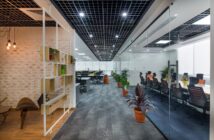Bottom Line: Landlords, occupiers to rethink operating strategies according to changing workforce demands, says a Colliers Research.
 Colliers International released its latest insights report – Flex, Core and the Cloud: A Blueprint for the Future Asia Pacific Workplace. The report, based on field research and interviews with some of the world’s leading organisations in the technology, financial services and FMCG industries, addresses the adoption of cloud technology in companies’ workforce models and broader implications for productivity and employee well-being.
Colliers International released its latest insights report – Flex, Core and the Cloud: A Blueprint for the Future Asia Pacific Workplace. The report, based on field research and interviews with some of the world’s leading organisations in the technology, financial services and FMCG industries, addresses the adoption of cloud technology in companies’ workforce models and broader implications for productivity and employee well-being.
Cloud computing, fueled by Internet of Things (IoT), has given rise to a new era of real estate possibilities for Asia Pacific companies and their workforces. By allowing firms to store and process virtually limitless amounts of data remotely, the cloud is enabling what Colliers International terms the Internet of the Workplace (IoW) – a digitally integrated enterprise architecture that exists in the virtual as well as the physical realm, connecting employees and allowing them to collaborate regardless of location.
“With physical infrastructure struggling to keep pace with the ever-advancing technology, the need to be ‘connected’ has never been more important. Remote working and access to data are forefront in firms becoming efficient and agile. Flex & Core is a pioneering concept, which allows firms to commit only to a certain % of real estate whilst keeping flexibility to increase or decrease their portfolio depending on the ever-changing business environment,” says Ritesh Sachdev, Senior Executive Director, Occupier Services at Colliers International India.
With a 7% share of total leasing volume in H1 2018, flexible workspace operators are making their presence felt in the market. Besides its cost-effectiveness and flexibility, use of flexible space is becoming more popular due to increasing uncertainty among occupiers regarding their future headcount growth. We expect the coworking concept to continue expanding notably in cities such as Mumbai, Bengaluru and NCR.
Like any transformation, clouding the workforce can prove disruptive for enterprises and the commercial real estate industry, forcing landlords and occupiers to adapt to new demands. Through careful planning and the right approaches companies can navigate this disruption while capturing the benefits of the cloud.
The four stages on the IoW curve are:
Traditional
Core operations/employees concentrated in a central location
Data/IT services stored, managed and delivered via in-house physical infrastructure
Employees have dedicated workspaces and rarely or never shift teams or locations
Transitioning
Key administrative functions and critical technology infrastructure based in a central location
Employees connected, and some data/IT services delivered via public or private cloud
Employees occasionally work on different teams or at different locations; enterprise provides limited IoT infrastructure to support occasional virtual teams
IoW Adopter
Technology infrastructure is almost entirely cloud-based
Core business functions spread across multiple hubs that scale according to business needs
Hubs employ BYOD and IoT technologies to enhance the working environment, and enable employees to work freely across teams and locations
IoW Powered
All technology infrastructure is cloud-based
No central location exists; employees log in independently from various IoT-optimised flexible workspaces or their homes
Employees form teams dynamically in response to business demands, using online platforms and collaboration tools to communicate, cooperate and achieve goals
Exercise caution: Despite the obvious benefits of IoW models, IoT by definition comes with a compromise on data security and companies’ increasing reliance on connected technologies creates heightened security risks, making data protection a significant challenge. A recent study showed, with more enterprises adopting BYOD policies, one in three CIOs in Hong Kong see their own employees as the organisation’s biggest security vulnerability.
Impact for Occupiers & Landlords
Occupiers:
Adopting cloud computing solutions help to reduce in-house infrastructure and real estate footprint resulting in lower capital and operational expenditure
Adopting BYOD policy and encouraging employees to work remotely reduces dedicated space allocation and enhances space efficiency
Positive impact on employee well-being and productivity with adoption of IoT
Adoption of IoW technologies makes offices more agile and enables cross-team collaboration
Landlords:
Develop more flexible lease structures and spaces to accommodate changes in occupier demands
Ensure buildings and office spaces are designed in a way to respond to rapid changes in occupier headcount
Consider alliances with flexible workspace operators to enhance the flexibility of their property portfolio
Evaluate whether the technical infrastructure of properties is sufficient to support IoW models





